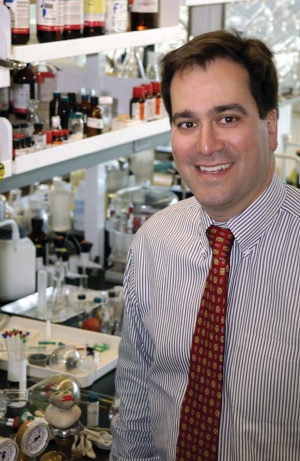Jun 24 2009
For Professor Chad Mirkin, good things come in small packages - specifically one billionth of a meter in size. Yet, as director of Northwestern University's International Institute for Nanotechnology, the impact of Mirkin's work is anything but small. A prolific inventor and entrepreneur, his innovations have the potential to transform the future of medical diagnostics and patient point-of-care and to ignite change across many industries from semi-conductors to healthcare. For his revolutionary discoveries and sizeable contributions to science and invention, Mirkin is awarded the prestigious 2009 $500,000 Lemelson-MIT Prize.

Mirkin, the George B. Rathmann Professor of Chemistry at Northwestern University (NU), will accept the prize and present his accomplishments to the public at the Massachusetts Institute of Technology during the Lemelson-MIT Program's third-annual EurekaFest, a multi-day celebration of the inventive spirit, June 25-27.
As a leader in the burgeoning field of nanotechnology, Mirkin is the author of 380 manuscripts and over 350 patents and applications, and is currently listed as the third most cited chemist over the past decade and the most cited nanomedicine researcher in the world.1,2 "Professor Mirkin's cutting-edge, innovative work is greatly contributing to America's economic competitiveness and will help ensure that the nation remains at the forefront of one of the most promising areas in science," states Congressman Daniel Lipinski of Illinois.
Mirkin is best known for the invention, development and commercialization of two revolutionary technologies - the nanoparticle-based medical diagnostic assays underlying the FDA-approved Verigene IDTM system and Dip-Pen Nanolithography (DPN), an ultra high resolution molecule-based printing technique. Both inventions were born, in part, out of Northwestern University's Nanoscale Science and Engineering Center, funded by the National Science Foundation, and conceived, managed and directed by Mirkin. There, Mirkin's research, with the help of NU graduate students and colleagues, has formed the basis of several start-up companies that are helping to bring his inventions from the lab to the market.
Nanotechnology as a Disease Detector
Current medical diagnostic tools make it challenging to understand the identities of molecules circulating in the human bloodstream, which provide early warning signs of disease. Often, a disease isn't detected until an illness has progressed and indicator molecules become visible in higher concentrations. Current genetic testing, often performed in a distant lab, may take weeks to deliver results and authenticate or rule out the presence of a threatening disease or illness - an inefficient and costly process with potential negative health consequences.
Mirkin invented a highly precise method of identifying low concentrations of disease-signifying molecules. "In the case of proteins, the test can be thousands of times more sensitive than any commercial protein detection system out there, and has the power to revolutionize medical diagnosis," states Mirkin. Mirkin commercialized many of the nanoparticle-based medical diagnostic assays through Nanosphere Inc., leading to the development of the Verigene ID System. This innovative biodiagnostic system can test patients for several different disease targets at the same time, on-site in a research laboratory, community hospital, or doctor's office in under an hour.
One of the most promising applications of this technology is in Alzheimer's disease, which presently affects as many as 5.3 million Americans.3 Today, patients can only be posthumously confirmed as having Alzheimer's. Mirkin's bio-barcode test has the potential to evaluate living patients for Alzheimer's by detecting very low concentrations of the protein associated with the disease, allowing for early intervention and potential treatment.
Mirkin's work with nanostructures made of gold has since led to new ventures and the founding of Aurasense, a company focused on developing a novel class of nanotherapeutics that are nontoxic and extremely effective in gene regulation for application in oncology and heart disease.
Manipulating Biological Materials with Dip-Pen Nanolithography
Printing is the cornerstone for many core technologies, including information transfer, electronics, medical diagnostics, and drug discovery. Modern microfabrication processes have made printing on the microscopic scale widely accessible. The challenge of creating flexible tools that allow one to print on the nanoscopic scale led Mirkin to invent Dip-Pen Nanolithography (DPN).
This technology, licensed by NanoInk, can be used to print features of proteins, DNA and other biological materials on surfaces with sub-50 nanometer resolution. Commercialized in the form of the NscriptorTM, it has become a novel research tool, allowing scientists to better understand how cells interact with surfaces and function, the chemical and physical consequences of miniaturization, and how structures - including individual viruses - behave at the single particle level. This knowledge is important for learning how viruses infect cells, understanding the chemical and physical differences between healthy and cancerous cells, or discovering the genetic code associated with a new flu virus - all of which could lead to new therapeutics and diagnostics. DPN's applications extend even further than this to highly miniaturized polymer- and molecular-based electronics.
Mirkin's latest invention, Polymer-pen lithography, which uses millions of polymer-based tips, is designed to cover a larger surface area and has more commercial applications ranging from computational tools, medical diagnostics like gene chips, and pharmaceutical discovery through combinatorial biomolecule arrays for screening drug candidates.
Engaging and Inspiring Young Scientists
Mirkin also serves as a role model and leader for aspiring young scientists and inventors. Through work with the International Institute for Nanotechnology, Mirkin and his colleagues devise innovative science programs around the country to educate youth including the development of the DiscoverNANO Web site, which introduces young people to nanotechnology. Currently, Mirkin is also working with the Museum of Science and Industry in Chicago to complete a hands-on nanotechnology exhibit.
"Mirkin is an extraordinary scientist who is at the forefront of the growing field of nanotechnology," states Michael J. Cima, faculty director of the Lemelson-MIT Program. "His inventions are paving the way for the emergence of nanotechnology in medicine, with impact that extends far beyond the scientific community. Mirkin is truly deserving of this honor."